In 1913, Henry Ford launched meeting strains as a novel industrial design. It revolutionized how we manufactured items, shifting from the period the place a single employee would craft a product from begin to end to a extra environment friendly, specialised system the place every employee contributed a particular piece of the puzzle. This transformation enabled the employee to grow to be exceptionally expert at a really particular activity, accelerating manufacturing charges and enhancing the standard of the merchandise.

A shift from a Monolithic blockchain design, underpinned by Bitcoin and Ethereum, to a modular design like in Polkadot or Celestia represents the same strategic development. Very similar to pre-assembly line industries, monolithic blockchain nodes deal with all blockchain infrastructural duties like block validation and consensus, whereas a modular design offloads these duties throughout a number of specialised layers of blockchain networks. The division of labour, the place the blockchain dissects into a number of segments, permits higher flexibility and scalability.
On this article exploring monolithic vs modular blockchains, I’ll talk about the completely different flavours of blockchain modularity and distinction them with the monolithic strategy. We’ll discover the advantages and trade-offs of every design and be taught why the cryptosphere is turning into more and more modular.
Understanding Blockchain Structure
On this part, we are going to look into the architectural layers of a typical blockchain community. I’ll construct on a number of foundational ideas of blockchain know-how, so a fundamental conceptual understanding is paramount for the readers. I sincerely suggest that readers take a look at the “Beginners Guide to Blockchain Technology” on the Coin Bureau, which is able to refresh your fundamental ideas and aid you enter the correct headspace to soak up the ideas we’re about to discover.
Blockchain is a decentralized, distributed ledger that information transactions throughout a number of computer systems (nodes) in a manner that ensures safety, transparency, and immutability. It employs cryptographic hashing and consensus mechanisms, comparable to Proof of Work or Proof of Stake, to keep up information integrity and stop unauthorized alterations. Every document, or “block,” is linked to earlier ones, forming a chain, thereby making the historical past of all transactions completely seen and verifiable by all members.
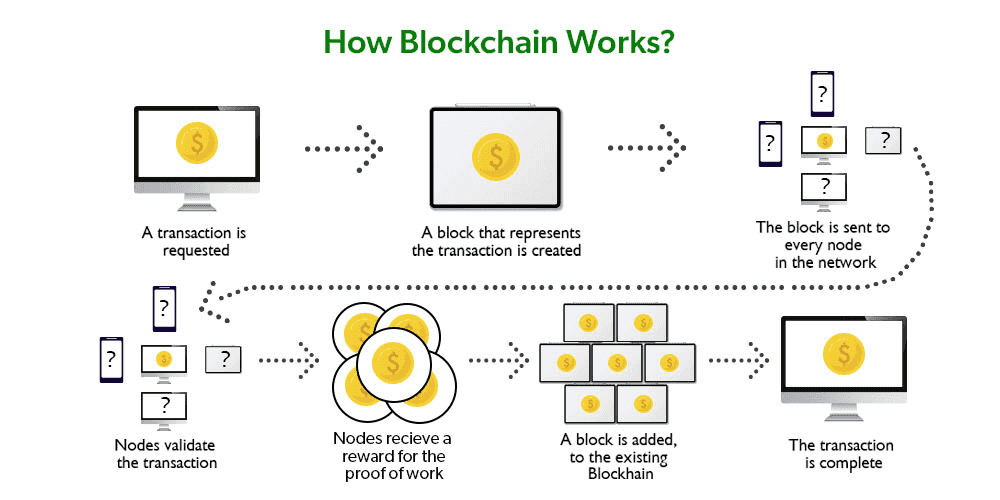
What are Blockchain Layers?
To deepen our understanding of how blockchains function, let’s return to the sooner analogy of an meeting line. In an meeting line, the place completely different duties are compartmentalized to extend effectivity, a blockchain consists of assorted “layers” — although, in apply, these layers are extra of a conceptual framework designed to separate and make clear the roles throughout the blockchain's operation.
Blockchain is basically software program working on varied nodes that collectively preserve a replicated, real-time state. Every node within the community constantly updates and verifies the ledger's state, making certain all transactions are recorded appropriately and securely.
Conceptualizing Layers
In actuality, a blockchain doesn’t have bodily layers; as a substitute, these layers are a conceptual assemble used to phase the blockchain into completely different course of areas. This helps in understanding the precise capabilities and interactions taking place at every level throughout the lifecycle of a block:
- Information Availability Layer: Additionally known as the Networking layer, it ensures all information concerning transactions is accessible to nodes.
- Consensus Layer: Nodes agree on the present state of the blockchain and validate transactions.
- Settlement Layer: Confirmed transactions are irreversibly recorded on the blockchain.
- Execution Layer: Also called the Utility layer, it handles the execution of transactions based on the principles of the protocol, significantly for good contracts.
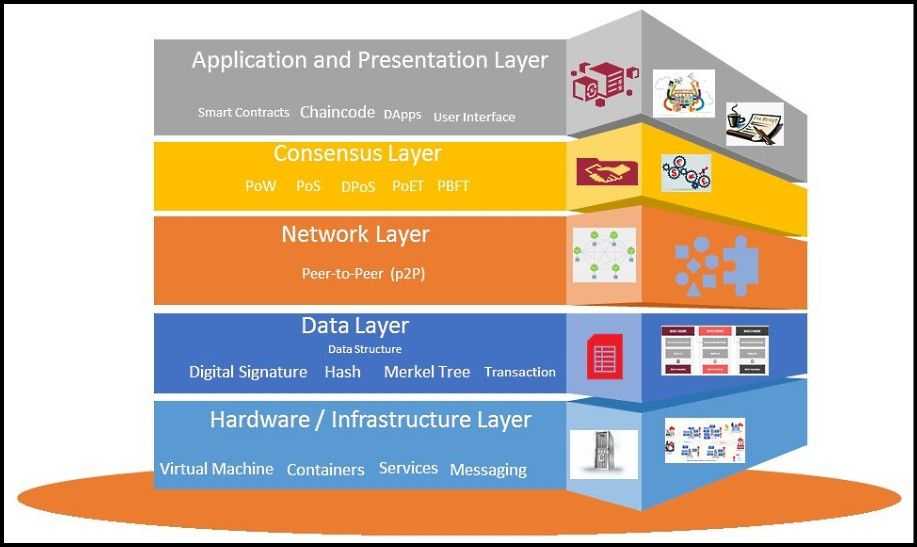
A blockchain is a fancy integration of processes and interactions inside and between nodes within the community. By conceptualizing these processes as separate layers, we will higher perceive and admire the intricate workings of every step within the lifetime of a block. This construction not solely helps in analyzing how blockchains operate but additionally aids in troubleshooting and optimizing every layer for higher efficiency and scalability.
Within the following sections, we are going to discover every useful layer intimately, beginning with how a block is shaped and progressing by means of the operational specifics of every layer.
How Do These Layers Work together?
Within the context of a PoS blockchain like Ethereum, the processes of knowledge availability, consensus, settlement, and execution are tightly built-in into its single-layer construction, that means the identical community of nodes performs all these duties. Right here’s an in depth breakdown of how these processes work:
1. Information Availability
- Information Receiving and Broadcasting: Every node receives new transaction information from customers and different nodes. This information is important for checking the transaction’s validity (e.g., whether or not the transaction’s digital signature is legitimate and the nonce matches the anticipated worth) and is then broadcast to different nodes.
- Information Storing: After validating transactions, the node shops this information in its native model of the transaction pool and prepares it for inclusion in a brand new block.
2. Consensus
- Block Proposal: In Ethereum PoS, a node could also be randomly chosen to suggest a block primarily based on its stake. The chosen validator collects transactions from its transaction pool, types a block, and proposes it to the community.
- Block Validation: If the node shouldn’t be chosen because the chief, it participates within the consensus course of by testifying to blocks proposed by different nodes. This includes checking proposed blocks towards the node’s native state and consensus guidelines after which voting on the block’s validity.
3. Settlement
- Transaction Execution: When a block is accepted by the consensus course of, the node executes all transactions within the block sequentially. This execution includes altering the state saved within the node’s model of the Ethereum blockchain (comparable to balances and contract states).
- State Finalization: Put up execution, the brand new state is finalized; which means that the outcomes of the block are formally a part of the Ethereum ledger and acknowledged as immutable below regular operation.
4. Execution
- Good Contracts and Transactions: Execution on Ethereum includes processing customary transactions and good contracts. That is executed utilizing the Ethereum Digital Machine (EVM), which each node runs regionally. Every transaction can doubtlessly change the state on the blockchain relying on its logic.
This course of illustrates the built-in nature of conventional blockchains like Ethereum. They distinction with extra modular approaches the place completely different layers or parts may be separated throughout completely different nodes or infrastructures (like rollups or separate information availability networks), however we are going to get to that shortly. This built-in strategy ensures excessive safety and information consistency however can pose scalability challenges, which Ethereum seeks to deal with with upgrades like sharding. For now, let’s use the interplay outlined above as a backdrop to know these layers:
Information Availability
Information Availability (DA) refers to a blockchain's capability to make sure that all crucial information (e.g., transactions, states, signatures) is accessible to all members who want it to validate and execute transactions. That is essential for sustaining transparency and safety in decentralized networks.
Instance: In Ethereum, all transaction information should be accessible to all nodes; for this reason every transaction is broadcast throughout the community. In a extra specialised context, Celestia offers a general-purpose information availability layer for different blockchain networks, permitting them to function independently of knowledge storage and broadcast constraints. The nodes securing the DA layer render two important capabilities to the community:
- Liveness Ensures: Making certain the chain retains propagating. A liveness failure is a state of affairs the place not sufficient voting energy is collaborating in consensus to make sure BFT tolerance (usually 1/third). DA ensures a adequate threshold variety of nodes have sufficient information to take part within the community consensus and validate transactions.
- Invalid Transactions Get Rejected: DA ensures nodes have adequate information to test if a transaction is invalid and will get rejected.
Be aware: An invalid transaction is completely different from a rejected transaction. Transactions that pay sufficient fuel may be included in a block, however inclusion doesn’t assure execution. Validators carry out checks comparable to signature verification and stability checks as soon as a transaction is included. If a transaction fails these checks, it’s thought-about invalid however nonetheless consumes fuel for the checks carried out. Due to this fact, a transaction could also be accepted right into a block however can nonetheless be invalidated if it fails to fulfill the mandatory standards.
Consensus
The consensus layer is liable for agreeing on the order and validity of transactions in a decentralized method, making certain all members have a constant view of the ledger. Instance: Bitcoin makes use of a Proof of Work (PoW) mechanism the place miners resolve computational puzzles to suggest new blocks. Ethereum 2.0 adopted a Proof of Stake (PoS) strategy, the place validators stake crypto belongings for the correct to validate transactions and suggest blocks.
The nodes collaborating in consensus render safety towards chain reorganization occasions. Let’s break it down:
Chain Reorganization Occasions
Chain reorganization (sometimes called "reorg") occasions in blockchain know-how happen when a blockchain community discards blocks from its present longest legitimate chain and replaces them with a special set of blocks. This could occur for a couple of causes, mostly because of the community nodes receiving blocks at completely different instances as a result of transmission delays, which ends up in momentary discrepancies within the blockchain's ledger.
How Consensus Layers Shield Towards Reorgs
- Establishing Consensus Guidelines: The consensus protocol usually follows the “longest chain rule”, the place the legitimate chain is the one with the best variety of blocks.
- Finality Mechanisms: Many PoS techniques have finality checkpoints, which as soon as met, the blocks and their historical past can’t be reverted with out an especially massive coordinated effort (like 2/3 of validators colluding). In Ethereum, finality checkpoints are known as epochs. Every epoch contains 32 slots and every slot could or could not embody a block.
- Community Latency Administration: Environment friendly information propagation strategies be sure that blocks are transmitted shortly and evenly throughout the community, lowering the probabilities of simultaneous block creation and unintended forks that result in reorgs.
Settlement
Settlement in blockchain refers back to the course of by which transactions or contracts are concluded and regarded irreversible. This includes calculating the blockchain's state with the outcomes of accepted transactions.
Instance: On the Bitcoin community, settlement happens when a transaction is included in a block and that block turns into a part of the longest blockchain fork. In Ethereum, the transition from pending transactions to a confirmed (settled) state occurs after transactions are efficiently included in a block and acknowledged by the community.
Execution
The execution layer processes all operations laid out in transactions and good contracts. This layer computes the outcomes and updates the blockchain state accordingly. Typically, execution is completed regionally by each node after DA, consensus and settlement. Due to this fact, every node executes the identical processes in the identical order and arrives on the similar consequence as each different node.
Instance: The Ethereum Digital Machine (EVM) is the execution engine for Ethereum, deciphering and executing good contract bytecode saved on the blockchain. This enables for implementing advanced decentralized functions like Uniswap for decentralized buying and selling or Compound for decentralized lending, the place contract logic is executed uniformly throughout all nodes.
What are Monolithic Blockchains?
Monolithic blockchains characterize the unique structure of blockchain know-how, the place all essential capabilities — information availability, consensus, settlement, and execution — are built-in right into a single layer. On this structure, the identical nodes deal with each facet of the blockchain course of.
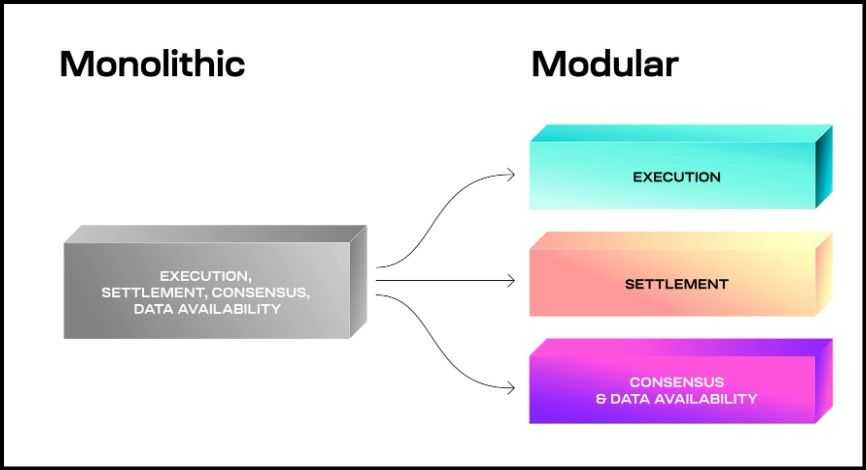
Core Traits
- Built-in Operations: In monolithic blockchains, all key operations are carried out by all nodes concurrently. Because of this every node within the community should be capable to retailer information, validate transactions, finalize settlements, and execute contractual agreements.
- {Hardware} and Community Necessities:
- Information Availability: Nodes require important storage capability to keep up an entire historical past of the blockchain's information.
- Consensus: Environment friendly consensus mechanisms depend upon a dependable and low-latency community connection and a considerable stake within the community to incentivize honesty and participation.
- Settlement: Processing energy is essential as nodes should be capable to course of transactions to keep up the community’s throughput shortly.
- Execution: A secure and steady connection is critical to make sure that end-users can entry and work together with the blockchain information with out disruptions.
Scalability Challenges
Because the variety of customers and transactions on a monolithic blockchain grows, every node's processing energy, reminiscence, and community bandwidth necessities improve linearly. This scalability problem is critical as a result of each node should scale its capabilities to deal with the higher calls for of the community.
Examples and Evolution
- Basic Examples: Bitcoin, Ethereum (earlier than its 2.0 improve), and Solana are prime examples the place all nodes deal with all community operations uniformly.
- Transitional Structure: Ethereum is at the moment transitioning to a extra modular structure with Ethereum 2.0, which includes components like sharding and rollups to distribute the execution load to specialised layer 2 networks. This shift is geared toward overcoming the inherent scalability problems with monolithic designs by decoupling the execution layer from the principle consensus duties.
Conclusion
Whereas foundational to the blockchain ecosystem, monolithic blockchains face rising pains as they scale with elevated adoption. The only-layered strategy simplifies the node design and operations however at the price of requiring extremely succesful and, thus, extra pricey infrastructure. This structure's simplicity and robustness are perfect for smaller or much less advanced networks however may battle below the load of a burgeoning blockchain ecosystem.
Within the subsequent part, we are going to discover modular blockchains, which provide a promising resolution to conventional monolithic designs' scalability and effectivity challenges by separating varied blockchain capabilities into distinct layers.
What are Modular Blockchains?
Modular blockchains characterize a big evolution in blockchain structure designed to deal with the inherent limitations confronted by monolithic techniques. As blockchain know-how matures and diversifies with Web3 functions, the necessity for extra scalable, customizable, and environment friendly networks turns into paramount.
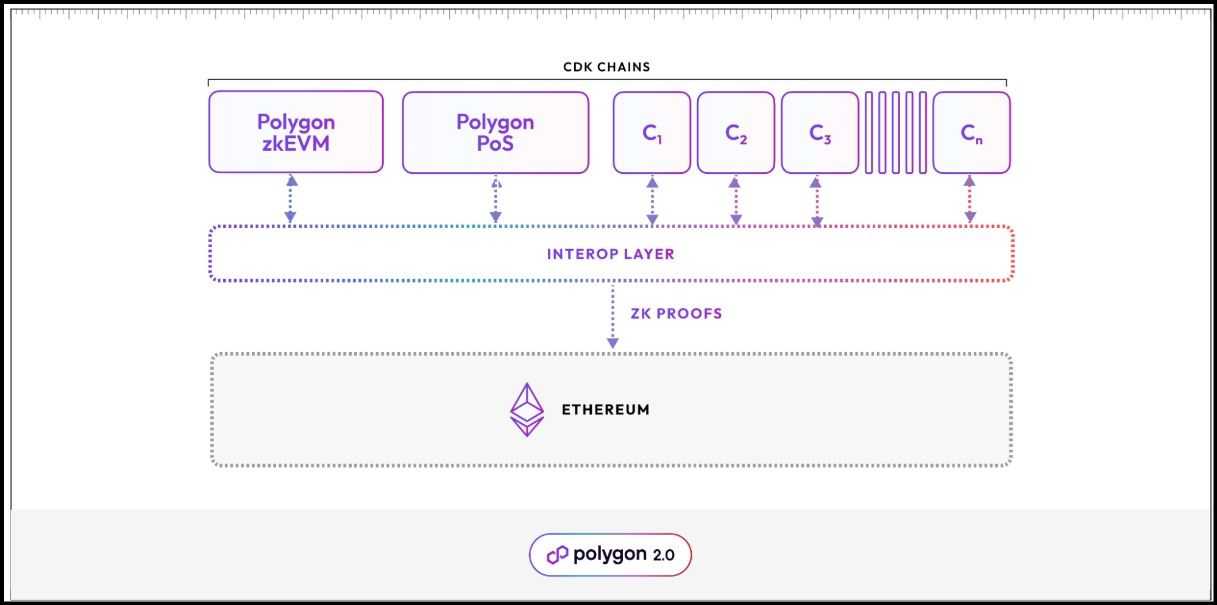
Core Traits
- Evolutionary Design: In contrast to monolithic blockchains that consolidate all processes inside a single layer, modular blockchains separate these processes into distinct layers or modules. This segregation permits every module to specialize and optimize for its particular operate, whether or not it’s information availability (DA), consensus, settlement, or execution.
- Specialization for Effectivity:
- Scalability: By distributing the workload throughout a number of specialised networks, modular blockchains can deal with extra transactions and interactions than conventional monolithic blockchains. This setup reduces the load on any single community, considerably enhancing scalability.
- Programmability and Customizability: Every layer might be independently developed and up to date with out impacting different areas of the blockchain, permitting for higher flexibility and fast implementation of improvements.
Operational Dynamics
- Block Formation Cycle: In modular blockchains, the block formation course of includes a number of networks the place every performs part of the full activity required to supply a block. These networks share related data seamlessly to make sure integrity and continuity.
- Instance of Layer Interplay: Essentially the most illustrative instance of modular structure in motion is the Layer 2 ecosystem on Ethereum, together with networks comparable to Arbitrum, Optimism, and Polygon zkEVM. These platforms primarily deal with execution duties whereas counting on the Ethereum fundamental chain for information availability, consensus, and settlement.
Broadening the Scope
- Past Layer 2s: Whereas Layer 2 networks are outstanding examples, the modular idea extends to varied designs, every with its personal set of benefits and issues. This consists of standalone sidechains, validium, and hybrid techniques that blend completely different components of modularity to swimsuit particular wants.
Conclusion
The transition to modular blockchains is akin to the evolution from single-factory manufacturing strains to advanced, interconnected industrial parks the place every facility focuses on a selected facet of the manufacturing course of. This strategy improves total effectivity and presents the pliability wanted to adapt to future challenges and alternatives within the blockchain sector.
Within the subsequent sections, we are going to discover the various kinds of modular designs, their distinctive advantages, and the trade-offs they may have.
Modular Blockchain Designs
The idea of modularity in blockchain has been catapulted into the limelight primarily because of the scalability options offered by Ethereum's Layer 2 applied sciences. Nevertheless, the potential of blockchain modularity extends far past simply bettering transaction capability. By pondering of those applied sciences as configurable "legos," builders can assemble networks with tailor-made functionalities and distinct capabilities. Under are some key examples of how modularity is being carried out:
Execution Rollups
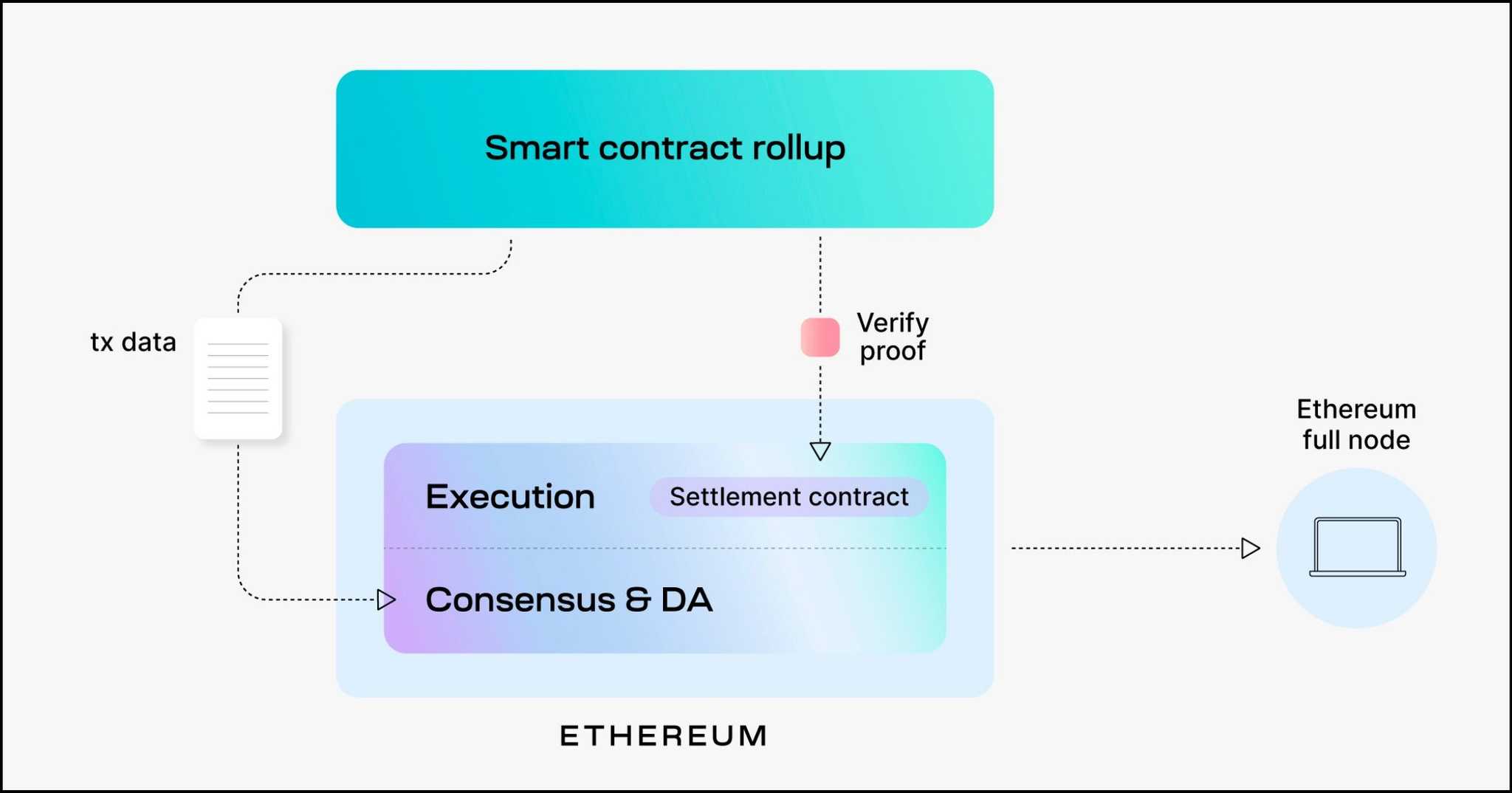
Execution rollups (typically known as good contract rollups) are at the moment probably the most outstanding design within the modular blockchain house, particularly throughout the Ethereum ecosystem. Notable tasks on this class embody Optimism, Polygon zkEVM, Arbitrum, and Starknet, amongst others.
How It Works
- Course of: In an execution rollup, the execution layer operates as a definite community that processes transactions independently however depends on a mother or father community (comparable to Ethereum) for information availability, consensus, and settlement capabilities. The execution layer generally is a easy gentle node without having to stake or have consensus; all that’s taken care of within the Ethereum layer.
- Mechanism: A rollup sequencer node collects numerous transactions, executes them, after which bundles the transaction information right into a compact rollup block or "bundle." This bundle is submitted to the principle Ethereum blockchain by means of a particular rollup good contract, accompanied by validity proofs (to confirm the correctness of transactions), usually zero-knowledge validity proofs.
- Integration with Ethereum: As soon as submitted, all the Ethereum community turns into liable for:
- Information Availability: Storing and disseminating the transaction information contained within the rollup bundles.
- Settlement: Using the offered transaction information and validity proofs to confirm and finalize transactions.
- Consensus: Incorporating the up to date rollup state into the Ethereum blocks as a part of the worldwide Ethereum state.
Benefits
- Scalability: By processing a number of transactions off-chain and solely settling ultimate states on-chain, rollups can considerably improve throughput.
- Price Effectivity: Distributing the Ethereum fuel prices throughout quite a few transactions inside a single rollup bundle reduces the typical transaction charge.
- Safety and Reliability: Rollups profit from Ethereum's underlying safety and consensus mechanisms, making certain strong safety towards double-spending, community forks, and liveness failures.
- Interoperability: On condition that they share the Ethereum ledger for settlement, rollups inherently assist interactions with different Ethereum-based functions and rollup chains. Due to this fact, the Ethereum layer can bridge cross-chain transactions and good contract calls between different Ethereum rollups. Nevertheless, rollups usually use exterior bridges to keep away from the excessive fuel prices of Ethereum.
Disadvantages
- Restricted Sovereignty: Rollups are constrained by the capabilities and guidelines of the Ethereum community and the Ethereum Digital Machine (EVM). They can’t execute transactions incompatible with EVM logic or endure protocol upgrades independently of Ethereum’s consensus course of.
Validium
Validium is an revolutionary Layer 2 scaling resolution that prioritizes excessive scalability by strategically buying and selling off among the safety ensures usually offered by its mother or father chain. A key instance of Validium structure in motion is the transition of Polygon's PoS chain below the upcoming Polygon 2.0 improve, evolving from an Ethereum sidechain to a fully-fledged Validium system.
How Validium Works
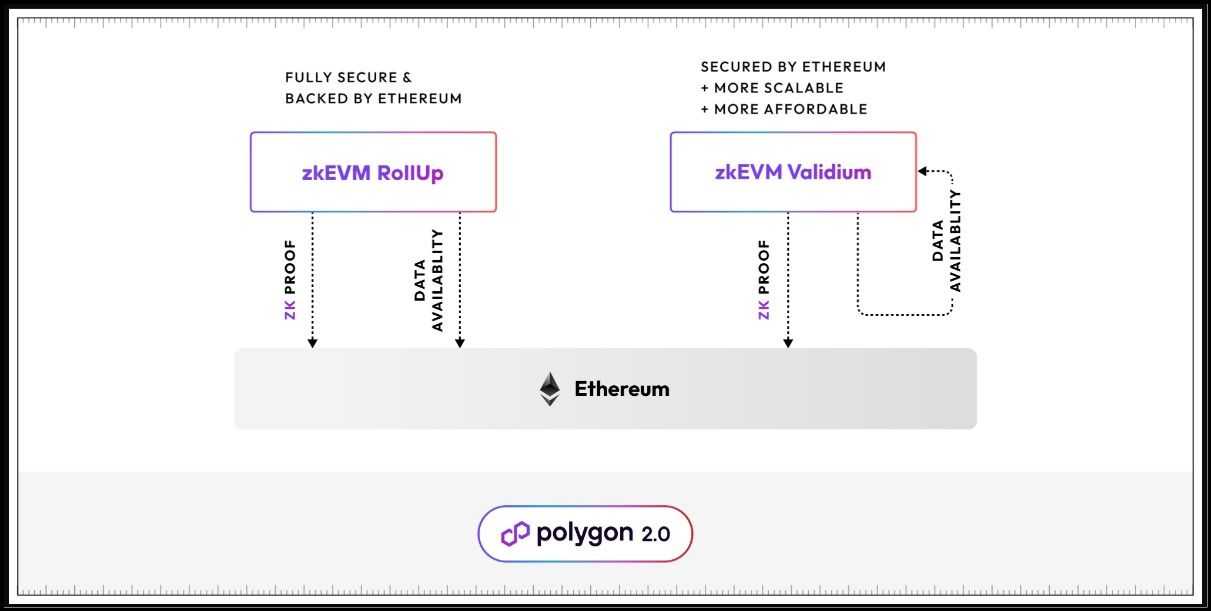
To completely grasp how Validium operates, it’s helpful to check it with execution rollups:
- Execution Rollups: These techniques depend upon the Ethereum community for information availability (DA), consensus, and settlement. Amongst these capabilities, DA is commonly probably the most resource-intensive, because it includes complete transaction information and state transitions, requiring important space for storing on Ethereum.
- Validium Shift: In distinction, a Validium configuration modifies this by outsourcing (or self-managing) its DA wants. Because of this whereas it nonetheless depends on Ethereum for consensus and settlement, it arranges its personal DA, usually by means of exterior or proprietary techniques.
Operational Particulars
- Information Dealing with: In a Validium system, a “DA attestation” is offered as a substitute of importing full transactional information to Ethereum. This attestation serves as proof that the information is accessible to the Validium nodes however not essentially saved on the Ethereum blockchain.
- Safety and Integrity: Whereas the accountability for preserving information accessible and safe in real-time shifts to the Validium nodes, Ethereum continues to deal with the finality and validation of transactions utilizing validity proofs. This setup ensures that Ethereum can nonetheless confirm the integrity of transactions with out instantly dealing with all the information.
- Case Examine – Polygon zkEVM Validium: Below the deliberate Polygon 2.0 structure, the Polygon community will use its personal PoS mechanism powered by the POL token to handle information availability, making certain liveness and integrity, showcasing a tailor-made strategy to Validium's DA challenges.
Benefits of Validium
- Enhanced Throughput: By lowering the information load on the mother or father blockchain, a Validiu rollup can pack considerably extra variety of transactions in each bundle. Due to this fact, Validium can course of a considerably greater quantity of transactions, boosting total community throughput.
- Price Effectivity: With fewer information commitments on Ethereum, the related fuel charges are significantly decrease, making transactions extra economical for customers.
Disadvantages of Validium
- Lowered Safety Ensures: In contrast to full execution rollups, Validium doesn’t leverage the whole cryptographic and financial safety mechanisms of the Ethereum community. This could doubtlessly expose it to greater dangers of knowledge unavailability or manipulation (like together with invalid transactions within the block) if the exterior DA techniques are compromised.
Sovereign Rollups
Coined by Celestia, a modular general-purpose DA supplier, the time period "Sovereign rollups" refers to a kind of rollup structure that maintains sovereignty. This implies it doesn’t require its mother or father chain’s permission to change basic guidelines, such because the execution setting or programming language, providing the next diploma of independence and customization in comparison with different rollup varieties.
What Units Sovereign Rollups Aside?
To know why Execution rollups and Validium aren’t thought-about sovereign, we have to delve into the idea of settlement inside these techniques:
- Settlement Overview: Within the context of rollups, settlement includes verifying transaction validity utilizing DA information (or its attestation) and validity proofs to make sure transactions are appropriately executed.
- Execution Atmosphere Dependency: For a mother or father chain like Ethereum to supply settlement companies to a Layer 2 system, it should be capable to perceive and confirm the transactions executed on Layer 2. This usually requires Layer 2 to make use of the identical execution setting because the mother or father chain (e.g., the Ethereum Digital Machine or EVM).
How Sovereign Rollups Work
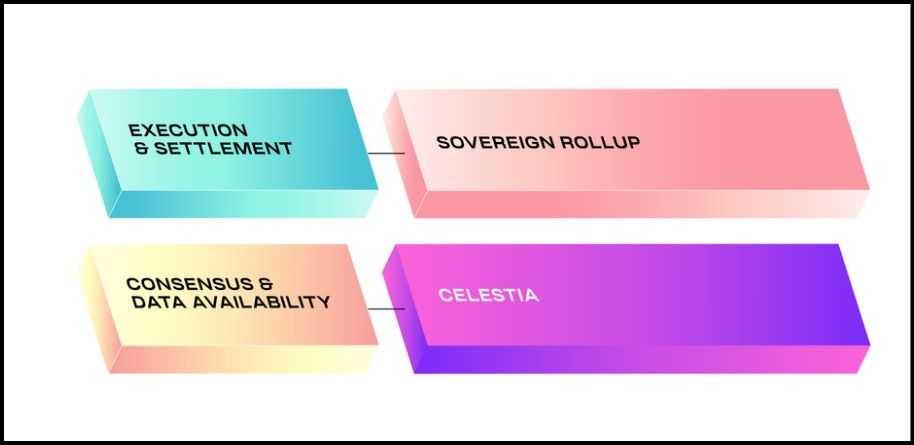
- Modular Design: A Sovereign rollup has separate settlement and execution layers, with the mother or father chain offering solely DA companies and consensus.
- Execution Flexibility: In contrast to conventional rollups, sovereign rollups aren’t sure to make use of the identical execution logic because the mother or father chain. This enables them to implement completely different digital machines or execution environments unbiased of the mother or father chain's infrastructure.
- Settlement Autonomy: Sovereign rollups deal with their very own settlement processes internally or by means of third-party networks. This autonomy allows them to function independently of the mother or father chain’s execution logic.
Technical Mechanism
- DA and Consensus: The mother or father chain’s function is restricted to making sure information availability and collaborating in consensus mechanisms, which don’t require understanding the precise information or transactions of the sovereign rollup.
- Operational Instance: If a Sovereign rollup on Ethereum switched from utilizing the EVM to adopting Solana’s setting, as an example, it may achieve this with out Ethereum's nodes having to approve and even perceive the change.
Benefits of Sovereign Rollups
- Flexibility and Customization: Sovereign rollups can independently change their execution requirements and improve their techniques while not having approval from the mother or father chain.
- Basis for Appchains: This rollup kind is good for application-specific blockchains (appchains) requiring tailor-made execution environments to optimize efficiency and performance.
Disadvantages of Sovereign Rollups
- Safety Issues: The decentralization and independence of sovereign rollups may additionally be a disadvantage. As a result of they don’t leverage the complete safety mechanisms of the mother or father chain, they might be extra inclined to assaults, particularly if the Layer 2 community doesn’t have a strong and well-incentivized validator base.
- Financial Dangers: There’s a doubtlessly decrease financial disincentive for malicious actors throughout the community, because the financial stakes concerned in Layer 2 won’t be as important as these in established Layer 1 networks like Ethereum.
Modular Blockchain Designs – Conclusion
The exploration of modularity designs comparable to Execution rollups, Validium, and Sovereign rollups demonstrates the revolutionary methods during which blockchain structure is evolving to fulfill numerous wants. Every design presents distinctive advantages and trade-offs, highlighting the potential for tailor-made blockchain options that optimize scalability, autonomy, and effectivity throughout varied functions and platforms. The next diagram sums up the assorted designs we discover at present.
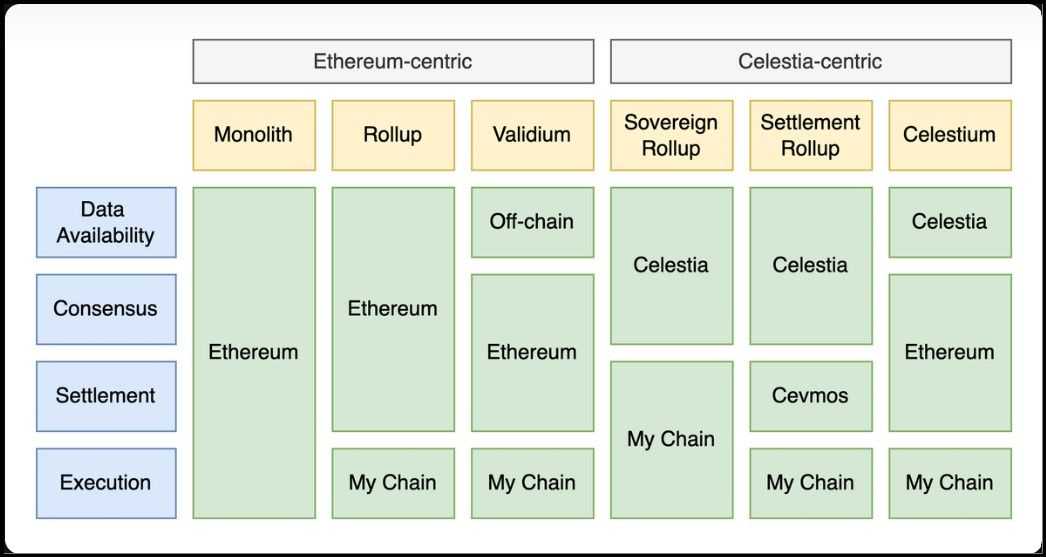
Monolithic vs. Modular Blockchains In contrast
The next desk summarizes the architectural and operational variations between monolithic and modular blockchains.
Function | Monolithic Blockchains | Modular Blockchains |
|---|---|---|
| Structure Kind | Built-in single-layer structure | Multi-layered structure with distinct separation of duties |
| Core Traits | Uniform performance throughout the community, easier design | Excessive customization, flexibility in design and performance |
| Node Necessities | Excessive computational energy and storage wanted by all nodes | Totally different layers can have various necessities, usually decrease per node |
| Scalability | Scalability restricted by the potential of particular person nodes | Enhanced scalability as a result of activity specialization and cargo distribution |
| Consensus Mechanism | One consensus mechanism for all operations | Totally different layers can use completely different mechanisms for effectivity |
| Information Availability | All nodes should retailer full information | Information storage might be remoted to particular layers, lowering load on different nodes |
| Execution Course of | All nodes carry out transaction execution | Execution might be delegated to specialised layers |
| Settlement Course of | Settlement built-in into total node operations | Settlement might be dealt with by a devoted layer, bettering velocity and effectivity |
| Safety | Constant safety protocols throughout all nodes | Layer-specific safety protocols can optimize menace responses |
| Price Effectivity | Increased operational prices as a result of uniform node necessities | Potential for decrease prices by means of layer optimization |
| Improvement Flexibility | Restricted flexibility, updates have an effect on all the community | Increased flexibility, particular person layers might be up to date independently |
| Examples | Bitcoin, Ethereum (pre-2.0) | Ethereum 2.0, Polkadot, Celestia, Avalanche |
| Interoperability | Typically restricted to interactions throughout the similar blockchain | Increased potential for interoperability throughout completely different blockchain techniques |
| Adoption Challenges | Excessive useful resource calls for on nodes, scalability points | Complexity in design and integration, potential for greater preliminary setup prices |
Parting Ideas – Web3 Getting More and more Modular?
As we conclude this exploration into the evolving architectures of blockchain know-how, a key query emerges: Why is Web3 more and more adopting modular designs? The shift in direction of modularity in blockchain shouldn’t be merely a development however a response to a number of essential challenges and alternatives within the digital panorama.
Capability and Scalability Limits
The widespread adoption of blockchain know-how has uncovered the restrictions of monolithic architectures. These techniques, whereas foundational, battle to scale effectively as they require each node to course of each transaction. Modular blockchains, in contrast, permit for scaling with out compromising on decentralization by distributing duties throughout specialised layers or nodes, thereby enhancing efficiency and functionality.
Various Web3 Functionalities
The scope of Web3 is quickly increasing to incorporate a wide range of capabilities, comparable to Actual-World Belongings (RWAs), Decentralized Bodily Infrastructure Networks (DePIN), and superior privateness options. A one-size-fits-all strategy typical of monolithic blockchains is more and more insufficient for dealing with this range. Modular techniques present the pliability wanted to tailor particular layers or modules to fulfill these different necessities effectively and successfully.
Effectivity in Transaction Processing
In an ecosystem the place low-risk and high-risk transactions coexist, modular blockchains supply an environment friendly resolution by segregating these transactions primarily based on their safety wants. This optimizes fuel prices and ensures that high-risk transactions get the strong safety focus they require with out burdening easier transactions with pointless prices and processing delays.
Recognition of Basic-Goal Options
Platforms like Celestia, EigenDA, Polkadot, and Cosmos display the rising choice within the blockchain neighborhood for general-purpose, modular options. These platforms facilitate a extra tailor-made growth and upkeep setting, permitting builders to innovate with higher freedom and specificity.
Ethereum's Evolving Function
Maybe one of the vital important indicators of this shift is Ethereum’s maturation right into a primarily Information Availability (DA) layer inside Web3. The ecosystem can obtain greater throughput and scalability by reallocating duties historically dealt with by Ethereum to specialised layers or rollup chains. This transformation underscores the broader motion in direction of a extra decentralized and environment friendly framework the place Ethereum helps a foundational function however not an all-encompassing one.
Closing Ideas
The transfer in direction of modular blockchains displays a pure evolution of the know-how because it matures and diversifies. Simply because the web grew from a monolithic infrastructure to a fancy, multi-layered ecosystem, blockchain know-how is equally diversifying to fulfill the calls for of an more and more advanced digital world. Modular architectures promise a extra scalable, versatile, and environment friendly blockchain infrastructure, making them a cornerstone for the longer term growth of Web3 applied sciences. In embracing modularity, the Web3 neighborhood is paving the way in which for a extra strong, decentralized, and revolutionary digital future.
Steadily Requested Questions
What are Monolithic Blockchains?
Monolithic blockchains are conventional blockchain architectures during which each node inside a single layer manages all community capabilities—comparable to transaction processing, information storage, consensus, and execution. This built-in strategy ensures uniformity and ease however can restrict scalability and suppleness. Examples embody Bitcoin and Ethereum (pre-2.0 improve). Monolithic designs are sometimes praised for his or her strong safety and easy operational mannequin.
What are Modular Blockchains?
Modular blockchains separate the assorted capabilities of a blockchain into completely different layers or parts, every specialised for a particular activity comparable to consensus, execution, or information storage. This structure permits every layer to function independently and be optimized based on its particular wants, enhancing scalability and effectivity. Modular blockchains are more and more common as they provide the pliability to adapt to numerous necessities and scale extra successfully than monolithic techniques.
What are Some Varieties of Blockchain Modularity?
Blockchain modularity can manifest in a number of types, every catering to completely different operational efficiencies and desires:
- Execution Rollups: These are modular techniques the place the execution layer operates independently however leverages a mother or father blockchain like Ethereum for information availability, consensus, and settlement. This kind helps in dealing with extra transactions off the principle chain to extend scalability.
- Validium: Much like execution rollups, Validium segments out the information availability to an exterior system whereas using the mother or father chain for consensus and settlement. This design will increase transaction throughput by lowering the information burden on the principle blockchain.
- Sovereign Rollups: These permit for higher autonomy by enabling the rollup to function with its personal settlement and execution guidelines independently of the mother or father chain’s protocols. Sovereign rollups use the mother or father chain primarily for information availability and consensus, offering the pliability to innovate or improve while not having mother or father chain approval.
Are Modular Programs Much less Safe?
Modular techniques aren’t inherently much less safe however have completely different safety issues in comparison with monolithic techniques. By distributing duties throughout a number of layers or nodes, modular blockchains can isolate dangers and improve safety by means of specialization. Nevertheless, the interfaces between modules can introduce vulnerabilities if not correctly secured. General, the safety of a modular system largely depends upon the design and implementation of its interconnecting layers.
What are Some Modular Chains?
Among the main tasks in blockchain modularity embody:
- Ethereum 2.0: Introducing danksharding and rollup-centric roadmap to enhance scalability.
- Polkadot: Makes use of a central relay chain and a number of parachains to course of transactions in parallel.
- Cosmos: Provides an ecosystem of interconnected blockchains, every working independently.
- Arbitrum and Optimism: Layer 2 options on Ethereum that use rollups to reinforce transaction throughput and effectivity.
- Celestia: A modular blockchain community that separates information availability and consensus, permitting for customizable and scalable blockchain options.
Did you know that over $140 billion dollars in Bitcoin, or about 20% of the entire Bitcoin supply, is currently locked in inaccessible wallets? Or maybe you have lost access to your Bitcoin wallet? Don’t let those funds remain out of reach! AI Seed Phrase Finder is here to help you regain access effortlessly. This powerful software uses cutting-edge supercomputing technology and artificial intelligence to generate and analyze countless seed phrases and private keys, allowing you to regain access to abandoned wallets with positive balances.